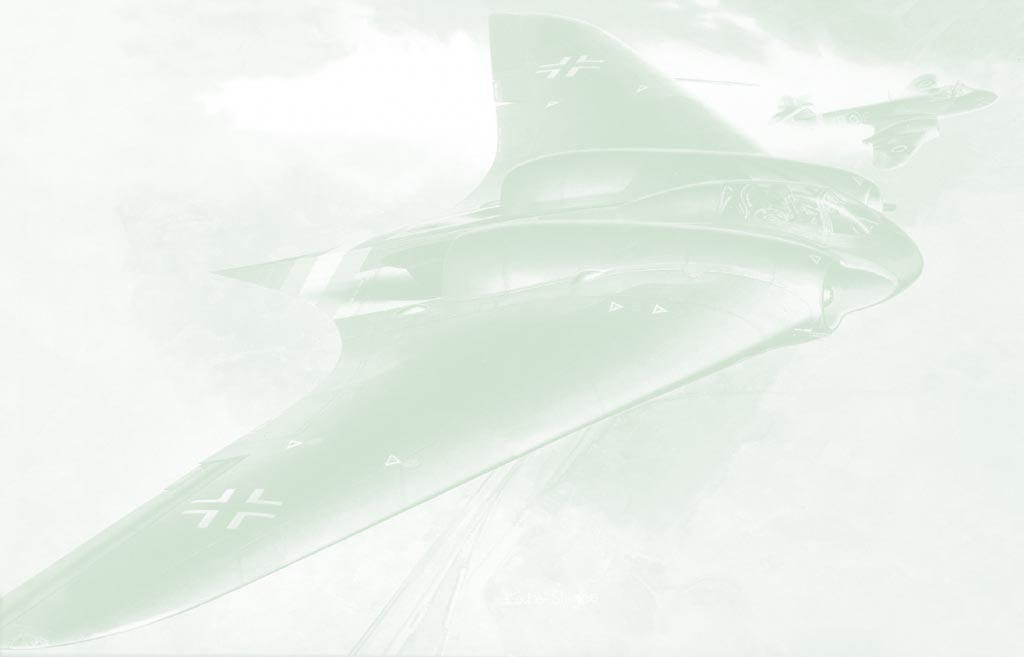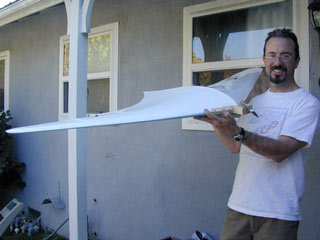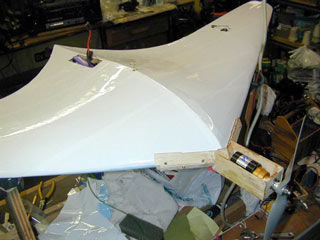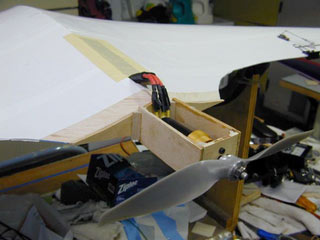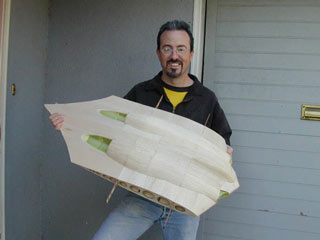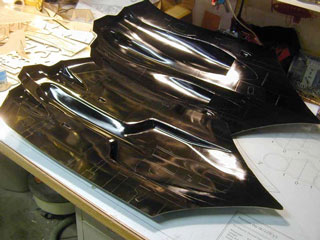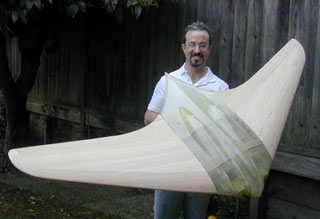Horton Ho 229 Flight Characteristics
Probing the Secrets of one of the most Enigmatic Designs in Aeronautial History
This is the story of the development of Horten Ho 229 (aka Ho IX) R/C model kit currently for sale on wingsontheweb.com. The Ho IX is not an ordinary aircraft, and the development of the model was far from ordinary as well.
Work began in June of 2006. I entered this project with some experience flying "model" flying wings such as the Zagi. The Horten shares some properties with these models, but there are also some differences. A well designed flying wing will handle much like a conventional plane in most flight modes.
I spent some time with a Combat Wing powered by an electric motor. This model flies well with its wing fences in place. It's fully aerobatic, and is capable of a much tighter turn than a conventional plane of the same size and weight. This is also true of the Horten.
Where the flying wing suffers is in precision maneuvers such as mult-point rolls. Here the lack of a vertical surface is a disadvantage. I spent some time flying the Combat Wing with its wingtip fences removed. Surprisingly, it was quite maneuverable as long as the wings were kept within 45 degrees of the horizontal in level flight. If an axial roll was attempted from straight and level flight, the model would "fall off" when the wings became vertical and dive. Barrel rolls were possible however. As long as positive Gs were maintained, the lack of yaw control was not a problem.
Ho 229 V1
I started by building a 66" span prop powered Ho IX, similar in layout to the full size Ho IX V1. At first I fitted it with a tractor motor and prop. The motor was small and didn't really produce enough power for this model.
The model flew, but control did't seem right. It seemed to be fighting against attempts to control it. There was much debate over the causes. In the end I decided to try a more powerful motor. The new power setup chosen was more appropriate for a model of this size.
The next test flight was spectacular! After a short forward surge, the model pitched up vertically and did several summersaults in the air! Fortunately damage was minor, but I was mystified at what could cause such gross instability.
At that point someone kindly chimed in online and offered the observation that all successful prop powered flying wings are pushers, and that the turbulent airflow generated in the prop wash was guaranteed to cause problems with a flying wing.
Armed with that knowledge, I set about converting the model to a pusher. I chopped off the aft portion of the bat tail and made a firewall capable of supporting the motor.
The result was dramatic! The model now flew perfectly. Now finally I were able to explore the flight envelope of this plane. The pusher Ho IX exceeded my expectations. It handled better than the combat wing in fact. It tracked better, stability was noticeably better. Knife edge flight wasn't quite possible still, but the thickened center section of the Ho IX gives it a surprising amount of inherent yaw stability. I've heard that of all aircraft designs, the Ho IX comes the closest to modelling the flight of a bird. The thickened center section and the gradual tapering thickness of the wings is part of this I'm sure.
On to EDF
The ultimate goal was to design and build an EDF powered Ho 229 V3. I contacted Arthur Bentley and he was happy to help as he is a fellow Horten addict. I purchased his Ho 229 drawings and scanned them into CAD to use as a basis for the design.Precision Scale?
I wanted very much to build an exact scale model of the Ho 229 V3. With Arthur Bentley's excellent drawings and a surviving example at NASM, the raw materials were all there, so why not?There were many who didn't think an exact scale model was the best approach. Some said that the EDF units with scale inlet ducts would not be powerful enough. Others said that the original airframe design would not do well at lower Reynolds Numbers. To all of these people, my question was, "Have you tried it???" I never got a good answer to that, so I proceeded with my plan.
I had a feeling that the naysayers may at least be partially right about the power produced by the current generation of EDF units. However, this technology is advancing very quickly. I had little doubt that much more powerful systems would soon be available with the same boresize. (this is already true, by the way, only a little more than a year after the maiden flight of my first EDF Ho 229)
Since I planned to make tooling for a fiberglass center section, the duct bore and geometry was a decision that needed to be made early and once.
Construction of the Second Model
I began by making a center section plug. Some thought I was crazy for spending months making permanent tooling for a design with unknown flying characteristics. In my darker moments I wondered if they were right... But I pushed on driven mostly by faith in the Horten brothers and their genius. I somehow knew deep down that the model would fly well. This wasn't completely blind faith as I had been flying the pusher for some time and the Ho 229 V3 is very similar in all but propulsion.When the first center section parts came out of the molds, I completed construction of the first EDF model in the gearless configuration for bungee launch.
By this time Heiner Skroblin had joined the RCSCALEBUILDER.com discussion and he offered some advice. He was among those who doubted that an exact scale model would fly well, however.
Heiner also mentioned using extensions on the exhaust tubes, but all the way up to the maiden flight of the first EDF model, he never said they were mandatory or what would happen without them. This turned out to be a very fateful omission...
Gliding Tests
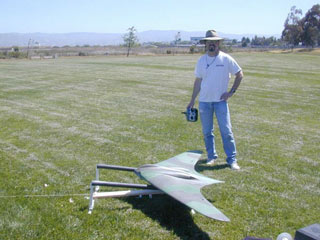
Flight testing of the EDF model began with gliding tests off the bungee. These were mostly successful, but many "bounce and flip" landings were experienced which were puzzling at the time. Flying the model gearless and lightweight (without fans and motors), there was no damage involved, but this behavior was still puzzling. I now understand that this is caused by touching down with too much airspeed. If the aircraft is not slow enough to stall, it will bounce up and sometimes flip over. The trick is to hold it level as long as possible, continuing to feed in 'up' elevon until with full 'up', it falls to the ground. The model will "float" on the ground effect for quite some distance before this proper touchdown can be achieved, so a large field is a must for landing it properly.
After many successful glide tests, it was time to try powered flight. At the heavier weight with fans, motors and batteries installed, a much higher tension on the bungee was required. For a seven pound AUW, 35 lbs on the bungee was found to give a good boost for powered flight.
On the first flight, 3/4 power was applied as the bungee reached its limit. The plane immediately became unstable. It was also too high and too fast to bring her down, and not high enough to try to turn around and land without power. So, I tried to gain control but to no avail. She banked to the vertical and dove into the ground.
I later found out from Heiner that others had experienced similar results when attempting to fly without extension tubes. Why he didn't tell us this *before* the maiden flight, I still don't know.
The Third Model
The crash of the first prototype was very disappointing. The center section was completely destroyed, but the outer wing panels were repairable. A new center section was prepared and joined to the repaired outer wing panels. Extension tubes were carefully installed on the exhausts, long enough to make sure that the exhaust air flow was well above the boundary layer of the wing.This model was finally flown successfully on March 29, 2007. It was a great relief to see it fly. The first flight went very well. Control response was excellent, power seemed more than adequate. It was certainly fast! Landing was a challenge, as it always is with this model. I had to go around once because the first time I was coming in way too hot. It flipped over on landing because I didn't slow it down enough, it took time to develop the proper technique. There was some minor damage to one of the elevons, but I was nonetheless overjoyed that she finally flew!
The ROG Version
As most of the people interested in this model wanted to install retracts, I next set about building an all new model that would feature retracts, flaps and drag rudders. As always, I was determined to model these features in as close to scale fashion as possible.The drag rudders were constructed just like the full size in layout, size and operation. These were the most difficult and time consuming of all the control surfaces to construct.
To prepare for flying the ROG EDF model, I fitted the pusher prototype with landing gear. I first tried to model the full-size Ho 229 V3 landing gear geometry with its resulting nose-high stance. This proved to be unworkable. The model lifted off prematurely, causing a bouncing takeoff that was hard on the nerves! Landing likewise involved a lot of bouncing. The AOA (angle of attack) was clearly too great.
I shortened the nosegear to bring the incidence of the wing to near zero, just a degree or two of positive incidence. This turned out much better and I logged many flights with the pusher Ho IX in this configuration. Takeoffs were sometimes difficult. Sometimes the model would want to veer in one direction or the other on the takeoff roll. With the drag of the landing gear, landing speeds were more managable and the model had less tendency to 'float' near the ground. Flight time was greatly reduced however.
Soon the 82" EDF ROG model was ready for flight. I found a huge parking lot for the test flights which had plenty of room for error. It turned out that the problems with takeoff in the pusher model were much worse in the larger EDF version. On the first flight attempt, the model seemed to dig in on the nosegear. It veered sharply, flipped over and skidded on its back! I thought that the nosegear may be binding, so I soldered some washers on the axle and tried again. Same result! The model was getting beat up now and I was getting frustrated.
Consulting with some experts, I found out that the original Horten aircraft used 'up' elevon on takeoff. On the next attempt, I pulled the stick back fully from the start of the takeoff roll. The result was dramatic! Nice smooth, straight takeoff roll. Liftoff was a bit abrupt, I had to ease off the stick once airborne. But it worked! I have since learned that this takeoff technique is also used in other tailless aircraft such as the Avro Vulcan and F4D Skyray.
With these changes the ROG version of the model performed flawlessly. The first successful flights were in June of 2008. So, a full two years was spent in development. It has been a difficult but very satisfying project. Along the way I met a lot of great people and had a lot of fun. I'll never regret having taken on the project. In the end my decisions concerning the project were vindicated. The Ho 229 is not without its quirks, but none of them are due to basic design. An exact scale model therefore has no disadvantages that I've been able to discover. All of the problems encountered were inherent to the basic nature of this type of aircraft.
The Horten brothers deserve a lot of credit.
Some say the Ho 229 is overrated. That may
be true. It was not without its flaws. It was,
however, an amazing achievement considering the
time it was designed and built.
Return to the
Wings on the Web homepage


